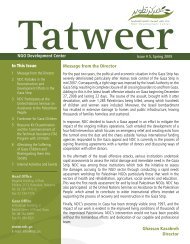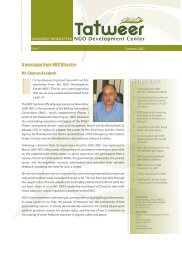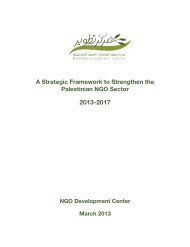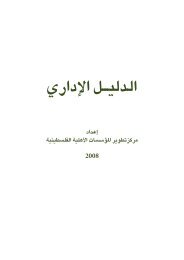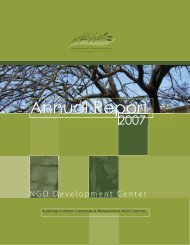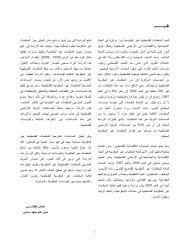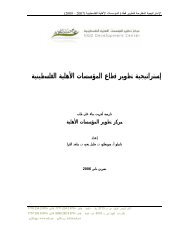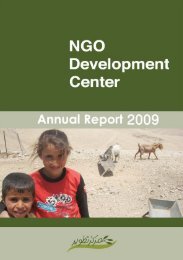Tracking External Donor Funding.pdf - NDC
Tracking External Donor Funding.pdf - NDC
Tracking External Donor Funding.pdf - NDC
Create successful ePaper yourself
Turn your PDF publications into a flip-book with our unique Google optimized e-Paper software.
V. The Evolution of the Palestinian Assistance Monitoring System (PAMS)<br />
In 2003 the MoP’s General Directorate for Aid Management and Coordination began an effort to track donor funding<br />
into the West Bank and Gaza Strip in a Mechanism known as PAMS, the Palestinian Aid Monitoring System.<br />
Through an interactive computer-based archive, donors were asked to submit the data from their projects, or enter it in<br />
directly, starting from the year 2002 7 . <strong>Donor</strong>s were asked for a basic amount of information primarily focused on type<br />
and conduit of aid.<br />
Type of Aid<br />
Conduits of Aid<br />
<br />
<br />
<br />
<br />
<br />
<br />
Budget Support<br />
Emergency and Relief Assistance<br />
Development (technical assistance and institution-building)<br />
PNA<br />
UNRWA<br />
NGOs<br />
The process of asserting more and more control over both the data and coordination of international assistance to the<br />
WB&GS by the Palestinian Authority continued into 2005 8 . The PAMS data tracking system was updated, improved<br />
and placed under the control of a new MoP Directorate for Aid Management and Coordination (AMC), charged with<br />
monitoring project information’ (MOP 2005:2).<br />
According to the MoP, the information gathered in 2004 was significantly greater than in 2003, and included sector,<br />
budgets, contractual data and geographic location of the projects implementation. This was far above and beyond the<br />
previous year’s collection of data on only type and conduit.<br />
Despite the improvements, there was still a heavy reliance on data from the World Bank and, as in 2004’s report on aid<br />
in 2003, the MoP found it particularly difficult to access data from the NGO sector (2005:1)<br />
In May of 2008, the Ministry of Planning issued a report covering the 3 previous years of international aid flows to the<br />
occupied Palestinian Territories. The fact that the report was released three years after the previous one reflects the<br />
turbulence within the Palestinian Authority, and its return to a type of policy making normalcy under the Emergency<br />
Caretaker Government. By this time the PAMS system was beginning to generate much higher quality data in an easy to<br />
use system.<br />
V.1 Challenges of PAMS<br />
In the beginning of the PAMS effort, the MoP comments that donors were either unwilling or unprepared to give them<br />
the information needed to build a proper data base, forcing the first report from the AMC, <strong>Donor</strong>’s Assistance to the<br />
Occupied Palestinian Territories for the Year 2003, to rely heavily upon World Bank data, and the previously<br />
discredited data from MOPIC. The MoP’s attempt to gain access to the finances and activities of donors, under the<br />
auspices of the 2003 report by OECD, Harmonization of <strong>Donor</strong> Practices for Effective Aid Delivery 9 , was as an<br />
unwelcome encroachment, especially concerning international aid to NGO sector.<br />
7<br />
8<br />
9<br />
All projects which began prior to 2002 and were still ongoing do not have financial data broken down by years, rather it is all offered as the<br />
aggregate (prior to 2002).<br />
Prior to the creation of the PNA, international assistance was channeled essentially through UNRWA and NGOs. The last ten years have seen<br />
the PNA emerge as the leading service provider in the WB&GS. Moreover, the first phase of reconstruction, as well as the recent Intifada,<br />
resulted in a greater need for budget support, which at times absorbed almost half of the total annual aid disbursed in the WB&GS. By 2003,<br />
international assistance was channeled primarily through the PNA, 25% through UNRWA and 10% through NGOs’ (MoP, 2005:5).<br />
According to the report, ‘<strong>Donor</strong>s should provide partner governments with full information of aid flows. This should be done regularly and in a<br />
timely manner’ (OECD, 2003). For its part, the intentions of the MoP were clear. A new movement toward Palestinian ‘ownership’ over the aid<br />
process was beginning, one which has so far culminated in the 2007 Palestinian Reform and Development Plan. Regarding the OECD’s<br />
position, “the MOP strongly supports this recommendation and will take all measures necessary to implement it” (MOP, 2004:11).<br />
90


